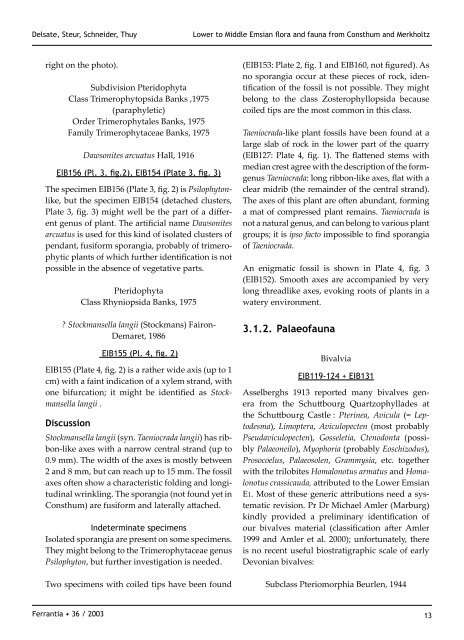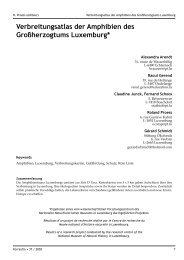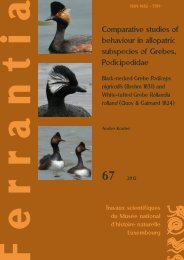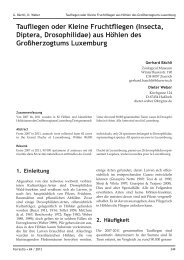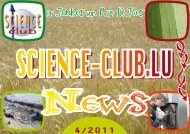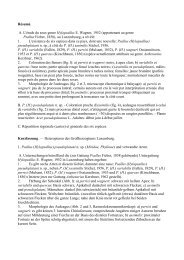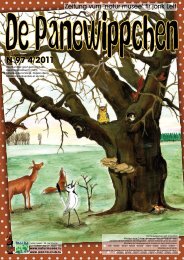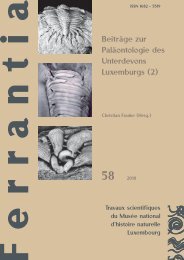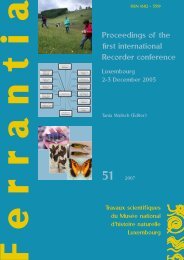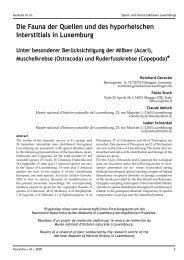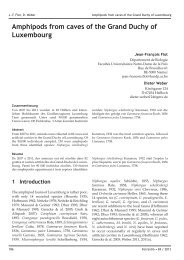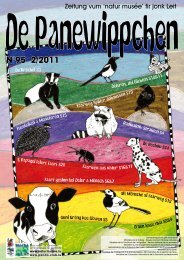Publi.complète - Musée national d'histoire naturelle
Publi.complète - Musée national d'histoire naturelle
Publi.complète - Musée national d'histoire naturelle
You also want an ePaper? Increase the reach of your titles
YUMPU automatically turns print PDFs into web optimized ePapers that Google loves.
Delsate, Steur, Schneider, Thuy Lower to Middle Emsian flora and fauna from Consthum and Merkholtz<br />
right on the photo).<br />
Subdivision Pteridophyta<br />
Class Trimerophytopsida Banks ,1975<br />
(paraphyletic)<br />
Order Trimerophytales Banks, 1975<br />
Family Trimerophytaceae Banks, 1975<br />
Ferrantia • 36 / 2003<br />
Dawsonites arcuatus Hall, 1916<br />
EIB156 (Pl. 3, fig.2), EIB154 (Plate 3, fig. 3)<br />
The specimen EIB156 (Plate 3, fig. 2) is Psilophytonlike,<br />
but the specimen EIB154 (detached clusters,<br />
Plate 3, fig. 3) might well be the part of a different<br />
genus of plant. The artificial name Dawsonites<br />
arcuatus is used for this kind of isolated clusters of<br />
pendant, fusiform sporangia, probably of trimerophytic<br />
plants of which further identification is not<br />
possible in the absence of vegetative parts.<br />
Pteridophyta<br />
Class Rhyniopsida Banks, 1975<br />
? Stockmansella langii (Stockmans) Fairon-<br />
Demaret, 1986<br />
EIB155 (Pl. 4, fig. 2)<br />
EIB155 (Plate 4, fig. 2) is a rather wide axis (up to 1<br />
cm) with a faint indication of a xylem strand, with<br />
one bifurcation; it might be identified as Stockmansella<br />
langii .<br />
Discussion<br />
Stockmansella langii (syn. Taeniocrada langii) has ribbon-like<br />
axes with a narrow central strand (up to<br />
0.9 mm). The width of the axes is mostly between<br />
2 and 8 mm, but can reach up to 15 mm. The fossil<br />
axes oen show a characteristic folding and longitudinal<br />
wrinkling. The sporangia (not found yet in<br />
Consthum) are fusiform and laterally aached.<br />
Indeterminate specimens<br />
Isolated sporangia are present on some specimens.<br />
They might belong to the Trimerophytaceae genus<br />
Psilophyton, but further investigation is needed.<br />
Two specimens with coiled tips have been found<br />
(EIB153: Plate 2, fig. 1 and EIB160, not figured). As<br />
no sporangia occur at these pieces of rock, identification<br />
of the fossil is not possible. They might<br />
belong to the class Zosterophyllopsida because<br />
coiled tips are the most common in this class.<br />
Taeniocrada-like plant fossils have been found at a<br />
large slab of rock in the lower part of the quarry<br />
(EIB127: Plate 4, fig. 1). The flaened stems with<br />
median crest agree with the description of the formgenus<br />
Taeniocrada: long ribbon-like axes, flat with a<br />
clear midrib (the remainder of the central strand).<br />
The axes of this plant are oen abundant, forming<br />
a mat of compressed plant remains. Taeniocrada is<br />
not a natural genus, and can belong to various plant<br />
groups; it is ipso facto impossible to find sporangia<br />
of Taeniocrada.<br />
An enigmatic fossil is shown in Plate 4, fig. 3<br />
(EIB152). Smooth axes are accompanied by very<br />
long threadlike axes, evoking roots of plants in a<br />
watery environment.<br />
3.1.2. Palaeofauna<br />
Bivalvia<br />
EIB119-124 + EIB131<br />
Asselberghs 1913 reported many bivalves genera<br />
from the Schubourg Quartzophyllades at<br />
the Schubourg Castle : Pterinea, Avicula (= Leptodesma),<br />
Limoptera, Aviculopecten (most probably<br />
Pseudaviculopecten), Gosseletia, Ctenodonta (possibly<br />
Palaeoneilo), Myophoria (probably Eoschizodus),<br />
Prosocoelus, Palaeosolen, Grammysia, etc. together<br />
with the trilobites Homalonotus armatus and Homalonotus<br />
crassicauda, aributed to the Lower Emsian<br />
E1. Most of these generic aributions need a systematic<br />
revision. Pr Dr Michael Amler (Marburg)<br />
kindly provided a preliminary identification of<br />
our bivalves material (classification aer Amler<br />
1999 and Amler et al. 2000); unfortunately, there<br />
is no recent useful biostratigraphic scale of early<br />
Devonian bivalves:<br />
Subclass Pteriomorphia Beurlen, 1944<br />
13


